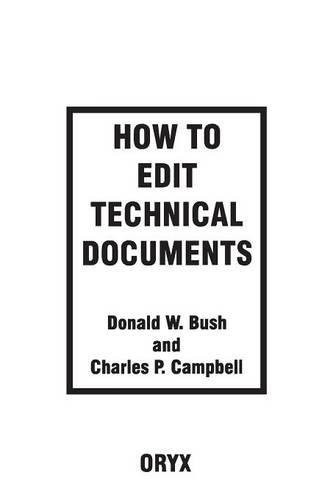
How to Edit Technical Documents
(Paperback)
Publishing Details
How to Edit Technical Documents
By (Author) Donald W. Bush
By (author) Charles P. Campbell
Bloomsbury Publishing PLC
Greenwood Press
28th April 1995
United States
Classifications
Professional and Scholarly
Non Fiction
Language learning: writing skills
Technology: general issues
808.0666
Physical Properties
Paperback
200
Width 152mm, Height 229mm
284g
Description
This work and the free workbook which accompanies it, give technical editors and students of technical editing a practical guide for editing both the substance and the structure of a technical document. The authors share their expertise as teachers and practitioners, showing the reader how a thorough understanding of technical English not only improves the quality of the edited piece, but also elevates the profession of technical editing to more than comma placement, spelling checks, and grammar corrections. significant attention is given to the concept of the "techology of English". The authors advocate that editors equipped with expertise in their own technology ar better prepared to work in successful parnership with technical writers, thereby producing a more readable finished product. Bush and Campbell also update age-old editing advice to reflect upon the modern reality of computers and electronic publishing as well English usage and grammar. A companion workbook accompanies this book, at no extra cost. It contains exercises, taken from actual technical reports and other documenrs, which should help students gain proficiency in technical editing as well as enabling editing professionals to hone existing skills or to develop new ones. Practice exercises, complete with suggested solutions, cover: following conventions (for example, style books, editing marks, grammar, punctuation and so on); using transformational grammar; improving sentences; improving paragraphs; and improving longer documents.
Reviews
[A] practical guide for editing both the substance and structure of technical documents. While primarily designed for editors, this 169-page guide and accompanying workbook will also help educators and students improve technical writing skills. * Tech Directions *
One pleasantly noticeable feature of these companion texts is their narrative voice. I find it comfortably readable and simultaneously authoritative without sounding overly dogmatic. The writing is vivid, opinionated, and yet not at all pretentious. . . . Bush and Campbell demonstrate a clear competence to speak about technical editing. This competency is based upon a real familiarity with workplace practices and competency is based upon a real familiarity with workplace practices and expectations and an updated and comprehensive knowledge of current research in the domains of rhetoric, linguistics, and cognitive psychology. * Journal of Business and Technical Communication *
[E]ssential reading for all technical communicators. . . . I found the accompanying workbook stimulating. . . . It is the direct approach of the book's principles that make Bush and Campbell's ideas powerful. . . . [A]n excellent textbook for advanced technical communication students. It also works as a discussion stimulator, refresher course, and research tool for experienced editors and writers. . . . [I]t will push you to think about some of the core values of our profession. * Technical Communication *
These two volumes could be a useful reference for any advisor involved in producing written material. * NACADA Journal *
[T]he best feature of How to Edit Technical Documents is that it makes you think about neglected aspects of the editor's work. . . . Their concept of the editor's job goes beyond the copyediting level to something that can reasonably be called technical editing rather than simply the copyediting of technical documents. . . . Perhaps the best chapter is on triage (i.e. editing manuscripts under deadline pressure), where the first task is to rea d the copy and see if it makes sense, rather than to first attack issues like consistency of capitilization. . . . As someone who came to editing from the science/engineering (rather than the language) side of the desk, I heartily agree with this approach. The authors also provide in this chapter a useful real-world example of a triage edit, which focuses on the organization of the document to make it at least understandable (if not well-edited in the traditional sense). * IEEE Transactions on Professional Communication *
Author Bio
Donald W. Bush is a lecturer in technical writing at San Diego State University and a former technical editor for McDonnell Douglas, St. Louis, Missouri, where he worked for 25 years. He has extensive experience in journalism, public relations, and technical editing, including seven years as public relations supervisor at Southwestern Bell Telephone Company. He has taught writing and editing courses at various universities and colleges and has written numerous articles and book reviews, mostly on technical writing and editing. Charles P. Campbell, PhD, is professor emeritus of English, Humanities Department, New Mexico Institute of Mining and Technology in Socorro, New Mexico. Previously, he taught English at several other universities and colleges. He has written and edited numerous articles, reports, book reviews, and films, and is a frequent presenter and lecturer on the subject of technical communication.
